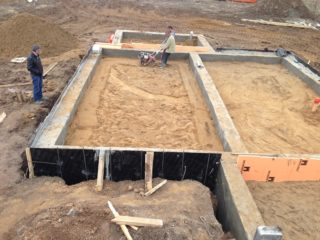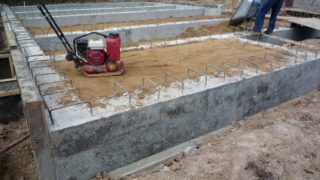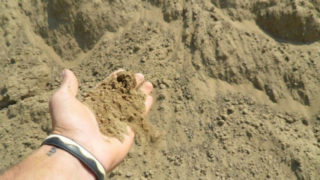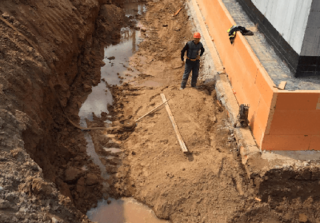Backfilling is carried out after the concrete, which forms the basis of the foundation, has completely hardened. Empty gaps often appear around the perimeter of the structure. To protect the soil from waterlogging, which can violate the integrity of the base, the lacunas are filled with filler.
Rules for backfilling the sinuses of the pit and the importance of the operation

Backfilling of the pit sinuses is regulated by SNIP 3.02.01-87. This document describes the requirements for the material with which the gaps of the trench will be filled, and the sequence of work. The target moisture and density parameters that the loaded soil must meet will vary depending on the soil type. Powerful vibrators are used to compact the backfilling of the pit sinuses.
The filler must be prepared in advance. It should be as homogeneous as possible. It is advisable to remove foreign bodies - pebbles, branches, pieces of bark and similar inclusions. Narrow sinuses should be filled with materials that are as less prone to shrinkage as possible - gravel or a mixture of sand and gravel. In no case should you use the fertile layer - it contains plant matter and organic compounds that will rot over time. Backfilling is prohibited when watering the walls and bottom of the trench. Moisture must be removed. For this purpose, you can equip a contour channel for drainage.
The construction estimate for the calculations will turn out to be more expensive, but this is the only method that helps to reduce the level of heaving.
The strip foundation is backfilled after two to three weeks after the concrete has been poured and the basement has been installed. It is important that the mixture has time to harden. It is not worth making a backfill foundation earlier than 2 weeks has passed - this will load the concrete, which can lead to the destruction of the structure. In addition, in the process of work, damage can be caused to an incompletely cured material. Water entering the cracks will cause the base to break down and rust on the rebar. The formwork frame must be dismantled before the start of work.
The trench to be filled up must be cleaned of debris and accidentally falling foreign objects. Then the moisture content of the soil is assessed. If the soil is prone to heaving, the optimal indicator is 12-15%. In heavy soils, a higher water content is allowed (up to 20%). Both soil dryness and waterlogging are harmful. If necessary, the soil is brought to the desired condition. Then a layer of sand (or its mixture with gravel) 0.3 m high is poured. After that, you can proceed to backfilling the foundation.
The purpose of the procedure is to create a bonding layer between the concrete tape and the natural local soil. In addition, protection of nearby soil layers from water erosion is ensured. This is necessary, since when the soil near the base is overwetted, there is a threat of violation of the integrity of the foundation, deterioration of its performance and reduction in service time.
Backfill soil compaction technology

Special technical equipment is required to organize the seal. Tamping the backfill manually is definitely not recommended - the process will take a long time and it will be difficult to achieve the desired density.A layer-by-layer scheme of work is used. The embankment is rammed until it reacts to this process. The thickness of one layer depends on the material used:
- for clayey soils, the value is minimal: the layer should not be thicker than half a meter;
- when using sandy loam and loamy soils, the highest value is 0.6 m;
- sand fillings can reach 0.7 m.
The fresh layer is treated with a trench leveler and rammer. The force during primary processing should not exceed 0.7 of the norm for the material involved. The next passes should overlap the previous one by ¼ or 1/3 of the width so that the vibrator plate has enough time to compact. The upper layers are laid under increased pressure. When erecting large (including two-story) buildings, a vibratory roller is suitable for compacting materials.
When the trench is backfilled, it is necessary to organize an inclined blind area to drain water from the foundation. Flooding of nearby soil is destructive to the established foundation.
Inside
If the homeowner does not plan to use the basement, backfill is made with clay inside under the concrete screed to protect against groundwater penetration. Having laid out a layer of 0.3 m, it must be tamped. Then a sand embankment is made, compacted, slightly moistened. A waterproofing layer of roofing material is laid on top. To reduce heat loss, another layer of sand is poured on which a screed is organized.
When organizing work on the inside, different types of soils can be used, which is associated with a lesser severity of temperature drops and threats of waterlogging. Do not forget about layer-by-layer compaction, as well as cleaning from foreign bodies.
Outside
External backfill is also implemented in a layer-by-layer scheme. The soil must provide sufficient drainage. To insulate the foundation from the outside, you can use polyurethane foam or foam. Expanded clay is inferior in efficiency to these materials, moreover, it is more difficult to mount.
The choice of material for backfilling the foundation

Different types of soil can be used. The main thing is that they comply with the norms of humidity and density. It is also very important that the filler does not change its qualities when exposed to water. To achieve the proper values of the last indicator, a special technology is used, which involves laying the material in thin layers, followed by compaction of each of them.
Sand
Sand and gravel mixtures are well suited for laying in sinuses due to their excellent drainage properties. With a well-organized blind area, this design guarantees reliable protection against heaving at low temperatures. Sanding also adds stability to the building box. It is also important that the material is easily rammed and retains its density well.
The lack of sand is moisture permeability. Because of this, water accumulates in the thickness of the backfill, which creates an overload of the waterproofing layer. Wetting the sole impairs the bearing qualities of the soil. A properly equipped blind area can improve the situation. The correct choice of slope and installation of waterproofing will prevent the accumulation of rain moisture. Drainage should also be arranged near the blind area. This will allow water to be diverted for further use on the farm (for example, to water garden and vegetable garden crops).
Gully sand is more suitable for placement in sinuses than pure river or quarry sand. This is due to the high content of salts and clay inclusions, which provide better compaction. Clean sand can be washed out by groundwater. Therefore, it is recommended to use it only in a mixture with half and half with gravel. The gully sand should not be washed - this will remove the binding particles. It only needs to be cleaned of inclusions of plant origin and other organic matter.
To calculate how much sand will be required for work, you can use an online calculator.The formula is tailored to work with different types of backfills. You can tamp the sand by slightly moistening it, if this does not harm the components of the base.
Clay materials

The best option is skinny clay, which almost does not absorb liquids. If you have to deal with a hard lumpy material, additives for plasticity are introduced into it, for example, sand (about 5%). The introduction of impurities does not affect the strength and shrinkage characteristics, but it greatly simplifies the ramming. The material is suitable for stony ground, as well as for houses erected in areas with low-lying soil waters.
Clay is good because it acts as a barrier to moisture, not allowing it to pass to the sole and protecting the latter from destructive influences. The downside of this material is the tendency to heaving. Clay absorbs moisture under certain conditions. The material is laid in thin layers, which are subject to compulsory compaction.
Consequences of improper backfilling of the foundation
Failure to comply with the pouring technology and the requirements for fillers can contribute to the leaching of the material, the accumulation of liquid in it, or destructive processes in the sole. Improper organization of waterproofing also contributes to the rapid deterioration of the base.
Dusty soils and mixtures containing a large amount of fine particles should not be used to fill gaps - they are easily washed out by groundwater. Peat and chernozem soils are not suitable for this purpose. Mechanical impurities (including pebbles) must be removed before backfilling, as they can damage the integrity of the waterproofing layer. It is not recommended to carry out the procedure in winter. During this period, there is a lot of moisture and ice in the soil, which negatively affects the compaction ability.
The backfill material must be homogeneous, comply with the regulated indicators of humidity and density, and not radically change its qualities from exposure to water. When performing work, the established technology must be carefully observed.









The SNiP cited by you has not been valid for 8 years. Actual SP 45.13330.2017